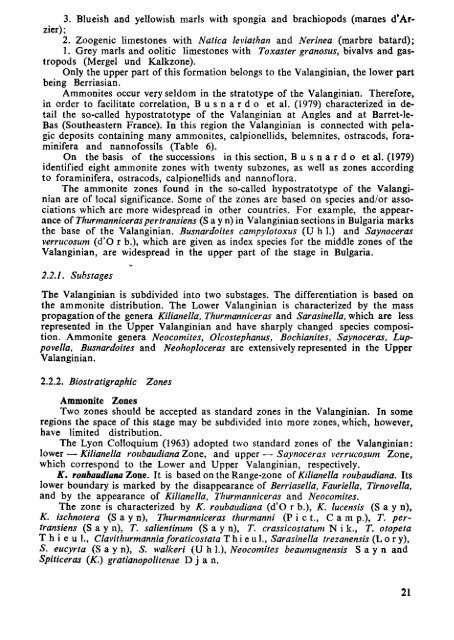THE MEDITERRANEAN LOWER CRETACEOUS
THE MEDITERRANEAN LOWER CRETACEOUS
THE MEDITERRANEAN LOWER CRETACEOUS
Create successful ePaper yourself
Turn your PDF publications into a flip-book with our unique Google optimized e-Paper software.
3. Blueish and yellowish marls with spongia and brachiopods (marnes d'Arzier);<br />
2. Zoogenic limestones with Natica leviathan and Nerinea (marbre bâtard);<br />
1. Grey marls and oolitic limestones with Toxaster granosus, bivalvs and gastropods<br />
(Mergel und Kalkzone).<br />
Only the upper part of this formation belongs to the Valanginian, the lower part<br />
being Berriasian.<br />
Ammonites occur very seldom in the stratotype of the Valanginian. Therefore,<br />
in order to facilitate correlation, Busnardo etal. (1979) characterized in detail<br />
the so-called hypostratotype of the Valanginian at Angles and at Barret-le-<br />
Bas (Southeastern France). In this region the Valanginian is connected with pelagic<br />
deposits containing many ammonites, calpionellids, belemnites, ostracods, foraminifera<br />
and nannofossils (Table 6).<br />
On the basis of the successions in this section, Busnardo et al. (1979)<br />
identified eight ammonite zones with twenty subzones, as well as zones according<br />
to foraminifera, ostracods, calpionellids and nannoflora.<br />
The ammonite zones found in the so-called hypostratotype of the Valanginian<br />
are of local significance. Some of the zones are based on species and/or associations<br />
which are more widespread in other countries. For example, the appearance<br />
of Thurmanniceraspertransiens (S a y n) in Valanginian sections in Bulgaria marks<br />
the base of the Valanginian. Busnardoites campylotoxus (U h 1.) and Saynoceras<br />
verrucosum (d'O г b.), which are given as index species for the middle zones of the<br />
Valanginian, are widespread in the upper part of the stage in Bulgaria.<br />
2.2.1. Substages<br />
The Valanginian is subdivided into two substages. The differentiation is based on<br />
the ammonite distribution. The Lower Valanginian is characterized by the mass<br />
propagation of the genera Kilianella, Thurmanniceras and Sarasinella, which are less<br />
represented in the Upper Valanginian and have sharply changed species composition.<br />
Ammonite genera Neocomites, Olcostephanus, Bochianites, Saynoceras, Luppovella,<br />
Busnardoites and Neohoploceras are extensively represented in the Upper<br />
Valanginian.<br />
2.2.2. Biostratigraphic Zones<br />
Ammonite Zones<br />
Two zones should be accepted as standard zones in the Valanginian. In some<br />
regions the space of this stage may be subdivided into more zones, which, however,<br />
have limited distribution.<br />
The Lyon Colloquium (1963) adopted two standard zones of the Valanginian:<br />
lower — Kilianella roubaudiana Zone, and upper — Saynoceras verrucosum Zone,<br />
which correspond to the Lower and Upper Valanginian, respectively.<br />
K. roubaudiana Zone. It is based on the Range-zone of Kilianella roubaudiana. Its<br />
lower boundary is marked by the disappearance of Berriasella, Fauriella, Tirnovella,<br />
and by the appearance of Kilianella, Thurmanniceras and Neocomites.<br />
The zone is characterized by K. roubaudiana (d'O г b.), K. lucensis (Say n),<br />
K. ischnotera (Say n), Thurmanniceras thurmanni (P i с t., Cam p.), T. pertransiens<br />
(Say n), T. salientinum (Say n), T. crassicostatum N i к., T. otopeta<br />
T h i e u 1., Clavithurmannia foraticostata T h i e u I., Sarasinella trezanensis (Lor y),<br />
S. eucyrta (Say n), S. walkeri (U h ].), Neocomites beaumugnensis S a y n and<br />
Spiticeras (AT.) gratianopolitense D j a n.<br />
21

















